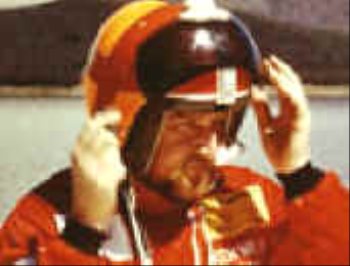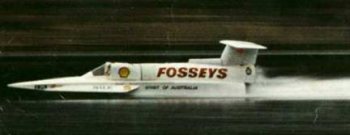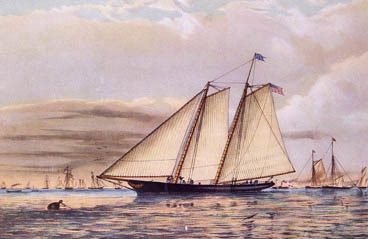|
The
Fastest
Well it seemed fitting after the
biggest to find out the fastest.
4000 years of naval construction, how
much has been gained in speed?
From ancient times until the 19th
century, the most efficient way of moving men and materials over great distances
was by sea. It was much more economical than transport by foot, cart, camel
caravan and was often safer too. Until the arrival of the airplane, it was also
the speediest way, as can be seen by these crossing times:
Sailing
ships:
-
1846 -
Yorkshire
left Liverpool for New
York crossed in 16
days
average speed 8.0 knots
-
1851 - Flying
Cloud left New
York for San Francisco crossed
in 89
days average
speed 7.1 knots via Cape Horn.
-
1853 - Northern Light left San Francisco for
Boston
crossed in 76
days
average speed 8.3 knots
-
1868 -
Thermopylae left
Liverpool for
Melbourne crossed in 63
days
average speed 8.0 knots
-
1905 -
Atlantic
left Sandy Hook for
England crossed
in 12 days 4 hours average speed 10.3 knots
Steamships:
-
1838 - Great
Western left
Bristol
for New York crossed in
15
days
average speed 7.8 knots
-
1934 -
Bremen left
Cherbourg for Ambrose Light
crossed in 4 days 14 hours average speed 28.0 knots
-
1937 -
Normandie left New
York for
Southampton crossed in 3 days 22 hours average speed 31.4
knots
-
1938 - Queen
Mary left Ambrose Light for Bishop's
Rock crossed in 3 days 20 hours average speed 34.0
knots
-
1952 - United
States left Ambrose Light for Bishop's Rock
crossed in 3 days 10 hours average speed 35.8 knots
The Flying Cloud of 1851 was the most famous of the
extreme clippers built by Donald McKay in East Boston, Massachusetts, intended for Enoch Train of
Boston, who paid $50,000 for her construction. The Flying
Cloud was purchased at launching by Grinnell, Minturn &
Co., of New York, for $90,000,
which represented a huge profit for Train & Co. Within six weeks she sailed
from New York and made San
Francisco 'round Cape
Horn in 89
days, 21
hours under the command of Captain
Josiah Perkins Creesy. In the early days of the California Gold Rush, it took more than
200 days for a ship to travel from New York to San Francisco, a voyage of more
than 16,000 miles. On the 31st of
July, during the trip, she made 374 miles in 24 hours. In 1853 she beat
her own record by 13 hours, a world beating record that stood for 136 years,
until 1989 when the breakthrough-designed sailboat Thursday's Child
completed the passage in 80 days, 20 hours. The record was once again broken
2008 by the French racing yacht Gitana 13 with a time of 43 days and 38
minutes.
The Flying Cloud's achievement was remarkable under any
terms. But, was all the more unusual because her navigator was a woman, Eleanor
Creesy, who had been studying oceanic currents, weather phenomena, and
astronomy since her girlhood in Marblehead,
Massachusetts. She was one of the first navigators to exploit the
insights of Matthew Fontaine Maury, most notably the course
recommended in his Sailing Directions. With her husband, ship captain Josiah
Perkins Creesy, she logged many thousands of miles on the ocean,
traveling around the world carrying passengers and goods. In the wake of their
record-setting transit from New York to California, Eleanor and Josiah became
instant celebrities. But their fame was short-lived and their story quickly
forgotten. Josiah died in 1871 and Eleanor lived far from the sea until her
death in 1900.

The Flying Cloud
The Cutty Sark is the most famous British Clipper . Built in
1869, she served as a merchant vessel (the last clipper to be
built for that purpose), and then as a training ship until being put on public
display in 1954. She is preserved in dry dock in Greenwich,
London. However, the ship was
badly damaged in a fire on the 21st of May 2007
while undergoing extensive restoration. The Cutty Sark is the only remaining
original Clipper ship from the 1800's.
Etymology: The ship is named after the Cutty
Sark (Scottish for
short
chemise or
undergarment). This was the nickname
of the fictional character Nannie Dee (also the name of the ship's
figurehead) in Robert
Burns' 1791 comic poem Tam O'
Shanter. She was wearing a
linen cutty sark that she had
been given as a child, therefore it was far too small for her. The
erotic sight of her dancing in
such a short undergarment caused Tam to cry out "Weel done, Cutty-sark", which
subsequently became a well known idiom.
Her Portuguese nickname was Pequena Camisola - Portuguese for Little
Shirt
History: She
was designed by Hercules Linton and built in 1869 at
Dumbarton, Scotland, by the firm of Scott
& Linton, for Captain John "Jock"
"White Hat" Willis; Cutty Sark was launched
on November the 22nd of that year, and after
Scott & Linton was liquidated she was
completed by William Denny & Brothers for John Willis &
Son. Cutty Sark was destined for the tea
trade, then an intensely competitive race across the globe from China to
London, with immense profits to
the ship to arrive with the first tea of the year. However,
she did not distinguish herself; in the most famous race, against
Thermopylae in 1872, both ships left
Shanghai together on June the
18th, but two weeks later Cutty Sark
lost her rudder after passing through
the Sunda Strait, and arrived in London
on October the 18th, a week after
Thermopylae, a total passage of 122 days. Her legendary reputation is supported
by the fact that her captain chose to continue this
race with an improvised rudder instead of putting into
port for a replacement, yet
was only beaten by one week.
Career (UK,
Portugal)
-
Names:
Cutty Sark 1869-1895, Ferreira 1895-1916, Maria do Amparo 1916-1922, Cutty
Sark 1922 to date.
Tonnage:
975 GRT
-
Namesake:
Scottish witch Cutty
Sark
Displacement: 2,100 tons at 20 ft
draught
-
Christened:
The 22nd of November 1869 by Mrs.
Moodie.
Length:
212 ft
-
Acquired:
British Merchant
Navy
Beam:
36 ft
-
Commissioned: The 16th of
February
1870
Speed:
17.15 knots
-
Out of Service: December
1954 Capacity:
1,700 tons
-
Homeports:
London 1870-1895 Lisbon 1895-1911 Lisbon 1911-1923 Falmouth
1923-1938 London 1938 to date.
Motto:
Where there's a Willis a way
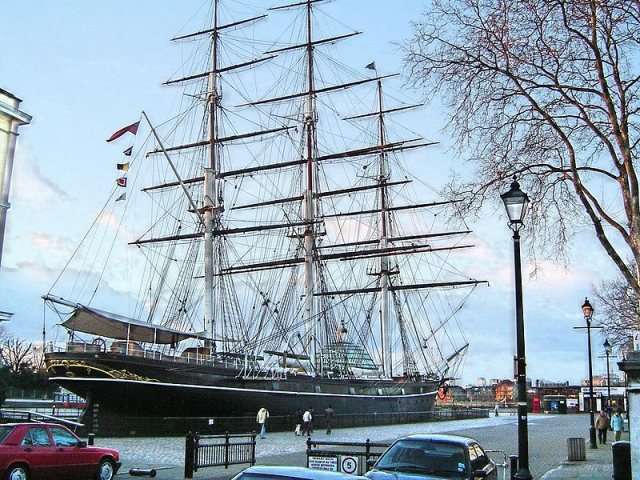
The Cutty Sark
In the end, clippers lost out to
steamships, which could pass
through the recently-opened Suez Canal and deliver goods more
reliably, if not quite so quickly, which proved to be better for business.
Notably, during the transition period to steam the Cutty Sark sailed faster than
some steamships including mail packets on a destination and condition basis
Cutty Sark was then used on the Australian wool
trade. Under the respected
Captain Richard Woodget, she did very well,
posting Australia-to-Britain times of as little as 67 days. Her best run, 360
nautical miles (666 km) in 24 hours (an
average 15 kn (28 km/h), was said to have been the fastest of any ship of her
size.
Although ships have improved greatly
in carrying capacity and safety they have improved surprisingly little in speed.
The ancient galleys sped along at 6 knots, the caravels of Christopher Columbus
in good winds at 7 knots and few modern ships ever exceed 25 knots. The reason
is that ships face large resistance factor due to moving through water, whereas
the wheel on land benefits from the small value of friction - particularly on
rails, and a plane in the air encounters very little resistance to motion. So it
is natural that much greater advances in speed have been made on land and in the
air. If you smooth out the numbers, there is a factor of ten between the speeds.
Boats 6 knots, car or train 60 knots and a plane 600 knots. There is a well
known definition of sailing as the slowest, most uncomfortable, most expensive
way to get from A to B. Funnily enough the way we have chosen to go round the
world.
The
Clippers
The clipper as it's name implies, is
a fast moving ship, in fact, the fastest type of commercial sailing ship ever
constructed. Developed in the US between 1830 and 1860, clippers became the
preferred ships for bringing immigrants to America, carrying fortune hunters to
California and Australia during the gold rushes and supporting the strong
commercial expansion of the US during that period. Clippers were designed for
speed rather than carrying capacity. Normally three-masted with square sails,
averaging 200 feet in length and very streamlined. A long slender bow and very
tall masts with wide yards that allowed them to carry much more sail than other
ships of the day. The captains commanding these vessels were often obsessed with
speed, pushing their ships and crew to the limit.
At a time when merchant ships
spuddled along at 4 or 5 knots with their heavy hulls and round bows which had
hardly changed since the era of the Spanish galleon, the American clippers were
revolutionary. Fantastic long-distance racers, reaching speeds of 20 knots
reducing to less than 100 days trips that had taken nearly a year.
It was a time of record breakers. In
1845, the Rainbow made New York to China - round trip in seven and a half
months. The James Baines crossed the Atlantic from Boston to Liverpool in 12
days and went round the world in 133 days. The Nightingale did Shanghai to
London in 91 days. The Sea Witch did Canton to New York in 81 days and the
Challenge did Hong Kong to San Francisco in 33 days. In 1854, the Lightening
established the world record for distance covered in 24 hours at 436 nautical
miles, a distance only broken long after the advent of motor-powered ships. We
by comparison are happy at anything over a 100 nautical miles a day with an
average of around 120.
Why was the clipper born in the US
when the great naval power was England? The answer is found in the shipyards of
Baltimore on the Chesapeake Bay, which , since the late 18th century had been
turning out small, swift ships, firstly for the coastal trade, then for the
Caribbean Pirates, the American privateers during the war of 1812 against
England and finally, for the slave trade. Slave-ships had to be swift in order
to keep down the death toll affecting their wretched cargo and to escape the
English warships that pursued them after England and most of the major powers
banned slavery from 1811.
The clippers remained an Anglo-Saxon
speciality, first the US, then the UK and Canada. Not many were built elsewhere,
just a few in France, Germany, Denmark and Holland. America stopped building
clippers after 1860 due to a drop in demand. Great Britain carried on producing
them for the tea trade until 1870, but the opening of the Suez Canal in 1869 and
the arrival of the motor-powered ship marked the end.
The Taeping had set
off from China with a cargo of tea on the 30th of May 1866 and arrived at
London Docks on the 6th of September at 9.45pm. The 'Ariel' had departed on
the same day and arrived at the East India Dock on the 6th September at 10.15pm.
The first ship home with the new tea crop would be able to command a far higher
price for her cargo, so these beautiful ships, with their large area of sail and
sleek lines, were built for speed. Tea represented one of the main consumer
goods brought to Britain from the East.

Taeping and
Ariel
Speed records on
water.
The absolute speed record is the
Spirit of Australia, driven by Ken
Warby (born on the 9th of May 1939) who is an Australian motor
boatracer, he currently holds the water speed
record of 317.60 miles per
hour. This was set in Blowering Dam, part of the Snowy Mountains hydro-electric
scheme, near Tumut, New South
Wales, on the 8th of October 1978. "Spirit" was powered by
a 6000 horse power Westinghouse jet engine. As a child, Warby's
hero was Donald Campbell, who died attempting to break the record in
1967.
The record for a sailboat is 46 knots
over a distance of 500 metres, held by three Australians on Yellow Pages
Endeavour, a vessel with three planing hulls. There was barely 20 knots of wind
on the day of the record which was in 1993. The boat requires 15 knots plus to
take off, but once planing can go almost three times the wind
speed.
Ken Warby, Spirit of
Australia and Yellow Pages Endeavour
Charlie Barr:
( 1864 - 1911 ) was an excellent skipper, born in Gourock,
Scotland, he first apprenticed as a grocer before working as a commercial
fisherman. In 1884, he took a job with his older brother John, delivering a
sailing yacht, Clara, to America. Clara's racing success was such that in 1887,
John was selected to skipper the British challenger, a yacht called
Thistle, the representative of the Royal Clyde Yacht Club;
Charlie served as a member of the crew. Thistle was soundly defeated by yacht
Volunteer. In the process, however, the brothers Barr were
introduced to Nathaneal Herreshoff, and Charlie Barr's yachting
career was launched, he would sail Herreshoff-designs for much of the rest of
his professional sailing life.
The
America was a 19th century racing yacht which gave its name to the
international sailing trophy it was the first to win the America's
Cup, known then as the Royal Yacht
Squadron's "One Hundred Guinea Cup". The
schooner was designed by George Steers for
Commodore John Cox Stevens and a syndicate from the New York
Yacht Club. On the 22nd of August 1851, the
America won by eight minutes over the Royal Yacht Squadron's 53 mile
regatta around the Isle of Wight.
The
America
America's Cup
success: Captain Charles Barr was skipper of
the yacht Columbia in 1899 and defeated Sir Thomas Lipton's
Shamrock. Two years later, in 1901, Charlie Barr was again at
the helm against a Lipton sponsored racing machine, Shamrock II, a 137 foot
Watson-designed cutter. In 1903, Barr was the captain of the winning yacht
Reliance, one of the most famous racing yachts to be designed by
Nathanael Herreshoff. Barr was inducted into the America's Cup Hall of Fame
1993.
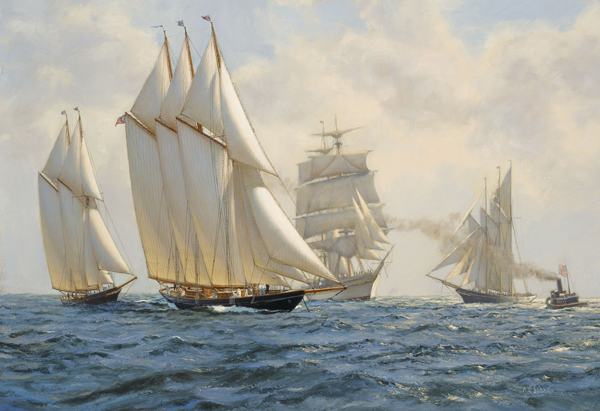
Atlantic at the start of the
race
Atlantic record: Charlie Barr is best
known for setting the record for the fastest crossing by a sailing yacht of the
Atlantic Ocean on the schooner named the
Atlantic in the legendary 1905 Kaiser's Cup Transatlantic Race,
crossing from Sandy Hook Light Ship, near New York to Point Lizard,
Cornwall, a distance of 2925 nautical miles. Barr made his crossing in 12 days,
4 hours, 1 minute and 19 seconds, a racing record that stood for 100 years
for the type of craft, 75 years for any class. Charlie benefitted from an
exceptional series of strong depressions on his crossing. On the other hand,
conditions were rough. When one of the storms was at its worst, the terrified
owner appeared on deck and called for the sails to be reduced. Barr answered
with "You hired me, sir, to win this race, and by God, that's what I am going to
do," and promptly sent the man back to his cabin.
The first to beat Barr's
record was Eric Tabarly in 1980 on the hydrofoil trimaran Paul Richard,
shortening Barr's time by 2 days, and new records have been set frequently since
then. The current record for a crossing by a single-hulled boat has been held by
Bernard Stamm on the Open 60 Armor Lux with a time of 8 days 1 hour, and for
catamarans since 2001 by Playstation with the incredible time of under 5
days.
The record for a distance covered in
24 hours is 695 nautical miles, established in 2002 by the English catamaran
Maiden 2.
St Malo, France -- Maxi catamaran
Maiden 2 has taken the English Channel record by cutting 57 minutes off the 1991
record. Maiden 2 took 5 hours and 24 minutes to
cross from Cowes, Isle of Wight to St Malo, France, finishing at 14:44:04 on
Tuesday. The previous record was set by American
adventurer Steve Fossett in his 38 metre (125 foot) catamaran PlayStation in
December 1991. The Maiden 2 team had an unofficial average speed of 25.7 knots.
Skipper Brian Thompson and crew member Helena
Darvelid were aboard PlayStation for the 1991 record, so both broke their own
record. "We're smoking! I can see St Malo and
were doing 26 knots of boat speed. The wind has held all the way contrary to
what was expected, we've had 15-16 knots the whole time," Thompson said during
the crossing. This latest record is Maiden 2's
fourth record in the last four months. It now holds the Antigua-Newport record;
the 24-hour speed record; the Round Britain and Ireland record and the Channel
record. Project director Tracy Edwards remained
ashore to find a sponsor for a Jules Verne non-stop round-the-world record in
early 2003. Edwards purchased Maiden 2 in March.
The boat was formerly called Club Med and sailed by veteran New Zealand sailor
Grant Dalton in The Race 2000, which it won in a 62-day non-stop
circumnavigation from Barcelona back to Marseille. 2002. British catamaran Maiden II has smashed the round Britain and
Ireland record, completing the course in four days, 17 hours and three minutes.
Britain's Brian Thompson skippered the catamaran
past the previous record, set by American Steve Fossett, in emphatic fashion.
Fossett's Lakota established the record of five
days, 21 hours and five minutes in 1994, but that time now lags over 28 hours
behind Thompson's record run. "We are very, very
pleased to have done the course and feel we did a good job," said
Thompson.
Antoine Albeau is a
French windsurfer who holds eleven Windsurfing World Championships in different
disciplines since 1994. Born on the 17th of June 1972 in La Rochelle,
France, Albeau set a new all-category world windpowered sailing speed
record on the 5th of
March 2008 with 49.09
knots (90.91 Km/h or 56.49 mph) on a 500 metre course at Saintes Marie de la
Mer, beating the
previous record which had been set by Finian Maynard with a speed of 48.70 knots in April 2005 at
the same spot. In October 2008 Antoine Albeau
successfully completed a cross channel windsurf from Cherbourg, France to Sandbanks, Poole. A crossing
of 75 nautical miles (138 kilometres) taking just over 6
hours.
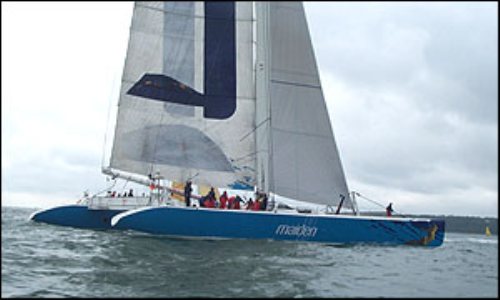 
Maiden 2
and Antoine Albeau
ALL IN ALL we
will stick to our record of six seconds doing 10.1
knots.
|




